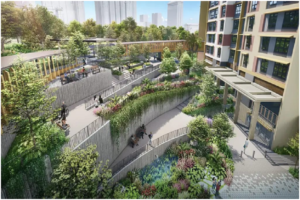
How to Choose the Best Architects in Singapore: Top 5 Tips Before Designing Your Dream Home
With Singapore’s land scarcity having 720 square kilometres for 5.5 million residents, strict URA guidelines, and rising design expectations, the architectural landscape in Singapore is a delicate dance between creativity and compliance. That’s where skilled architects in Singapore step in, not just to draw plans, but to translate vision into reality while navigating the regulatory minefield that is Singapore’s building code.
This article walks you through five essential tips to help you choose the right architectural partner. Not the flashiest, not the cheapest, but the one who gets it, someone who lives and breathes residential design. Someone who understands natural light, airflow, and spatial flow. And how to get your plans past the BCA without a bureaucratic tug-of-war.
Key Takeaways
- Choose architects in Singapore with landed property experience and verified BCA/SIA accreditation to ensure legal compliance and high-quality residential design.
- Clarify your lifestyle goals, design style, and budget upfront; architects use this to tailor the design process and manage expectations.
- Prioritise firms with strong portfolios, awards, and client testimonials—top boutique firms like Ming Architects offer integrated design-build services for standout results.
The Role of Architects in Singapore’s Residential Projects
What Do Architects in Singapore Do Beyond Drawing Plans?
Architects handle much more than just design sketches. They:
- Translate client ideas into workable designs
- Coordinate with engineers, contractors, and consultants
- Manage project timelines and budgets
- Ensure design feasibility and construction quality
How Do Architects Navigate BCA, URA, and Zoning Laws?
Architects ensure compliance by:
- Following BCA regulations on building safety, accessibility, and sustainability
- Securing URA planning permissions and adhering to zoning rules like setbacks and height limits
Coordinating with authorities for approvals and permits
Why Is Residential Expertise Important for Landed Properties or Bespoke Homes in Singapore?
Residential projects need specialised knowledge because:
- Landed homes face unique site constraints and neighbourhood rules
- Conservation and design guidelines must be followed if applicable
- Architects optimise natural light, ventilation, and layout for the local climate
- Approval processes can be complex and require experienced handling
Why Should You Hire Licensed Residential Architects in Singapore?
Choosing licensed architects in Singapore registered with the Singapore Institute of Architects (SIA) means:
- Professionals meet strict qualification and ethical standards
- They have experience with local building codes and regulations
- They keep up-to-date with industry best practices
- Clients receive accountability and professional protection
Licensed architects in Singapore, like Ming Architects, bring both creativity and compliance to your dream home project, ensuring it’s beautiful, functional, and above board. In the next sections, you will learn about the best tips we give to our clients before building and designing their dream homes.
Tip 1: Clarify Your Design Goals, Lifestyle Needs & Budget
Why Does Clarifying Your Vision Matter When Choosing Architects in Singapore?
Your vision is the compass for the entire project. Without it, you’re just wandering in the dark. Clear design goals help narrow down the list of architects who align with your taste and needs. Are you dreaming of clean lines and open spaces? Or maybe something lush and tropical? Knowing this upfront saves time and heartbreak later.
How Do You Define Your Style? Minimalist, Tropical Modern, Contemporary, or Sustainable?
Style isn’t just about looks. It’s how your home feels and functions every day. Here are some common approaches:
Featured Project: The Cradle House | Ming Architects
- Minimalist: Clean, clutter-free, with a focus on simplicity and function
Featured Project: Bloxhome House
- Tropical Modern: Embraces natural light, ventilation, and blends indoor and outdoor living
Featured Project: Carve House
- Contemporary: Sleek materials, bold forms, and up-to-date tech integration
Featured Project: Hideaway House
- Sustainable: Eco-friendly designs with energy efficiency and green materials
Pinpointing your style guides architects to present portfolios that match your dream home vibe.
How Can You Set a Realistic Budget and Work With Architects in Singapore?
Budget talks can be awkward, but skipping them can lead to unpleasant surprises. The right architect helps you prioritise:
- What you must have versus nice-to-haves
- Material choices that fit your financial plan without compromising quality
- Phased designs or flexible solutions to manage costs
An example: Ming Architects recently designed a modern home in Singapore that maximised space and light without breaking the bank, proving thoughtful design and budget-conscious planning go hand in hand.
Getting your goals and budget clear means your shortlist of architects will be focused on those who can make your dream home happen, beautifully and realistically.
Tip 2: Review Portfolios of Architects with Residential Specialisation
What Should You Look for in Portfolios of Architects in Singapore?
Portfolios are the proof of the architect’s work. You, as a client, can also benefit from reviewing the architect’s portfolio because it gives you a feel for whether their work and taste are aligned with your vision. When reviewing portfolios, you must focus on:
- Innovation: Are they pushing boundaries or playing it safe?
- Spatial flow: Does the layout feel natural and comfortable?
- Material use: Do they combine aesthetics with durability, especially for Singapore’s climate?
A well-crafted portfolio shows consistency and versatility, proving the architect can handle your unique needs.
Why Is Experience with Landed Property or GCB Projects Important?
Designing a Good Class Bungalow (GCB) or landed property in Singapore isn’t just upscale; it’s a whole different ballgame. Architects familiar with these projects understand:
- URA’s strict guidelines for setbacks and plot ratios
- How to balance grandeur with livability
- The value of heritage and site-specific conditions
Ming Architects, for example, has a strong track record in landed home designs, combining luxury with smart functionality.
Should You Rely on Online Portfolios or Visit Past Projects in Person?
Both have their place:
- Online portfolios give a quick overview and help filter choices.
- On-site visits reveal details that photos can’t capture, like lighting, scale, and craftsmanship.
Look up Ming Architects’ featured works online for inspiration, then, if possible, visit completed homes or ask for case studies. Also, check out industry leaders on ArchDaily or Dezeen for a broader benchmark of what top Singapore architecture firms are producing.
Tip 3: Verify Accreditation, Awards & Industry Standing
Why Should You Hire Accredited Architects in Singapore?
Designing a home is a creative process that also involves regulation. You want someone who’s not just imaginative but also officially qualified to build in this city of tight plots and tighter rules.
Look for accredited architects in Singapore who:
- Are registered with the Building and Construction Authority (BCA)
- Hold membership with the Singapore Institute of Architects (SIA)
- Appear in the SIA online directory (a quick credibility check that takes 30 seconds)
If they’re missing from that list? Keep walking.
What Awards Should You Look For in Top Architecture Firms in Singapore?
Awards indicate that your architect has the expertise to design a home that gets published. Here are some of the notable award-giving bodies in architecture:
- SIA Design Awards: the gold standard for Singapore-based architectural excellence
- BCI Asia Top 10: the award-giving body that recognises firms delivering consistent, large-scale impact in the region
A firm that’s consistently recognised for quality is likely doing something right, especially when peers in the industry are the ones handing out the praise.
How Do Testimonials and Media Mentions Add Credibility?
Good reviews from clients are helpful. Great reviews from editors? Even better. Check for:
- Client testimonials that mention responsiveness, creativity, and problem-solving
- Features in reputable media outlets like The Straits Times, ArchDaily, or Dezeen
- Repeat business or referrals are always a sign of trust
Ming Architects, for example, is often cited in both local and international design publications, a testament to their credibility in the residential space.
Choosing a firm with solid credentials means fewer surprises, better results, and a home that stands the test of both time and scrutiny. Begin your shortlist with the top architecture firms in Singapore that offer both awards and extensive experience.
Tip 4: Evaluate Communication Style and Design Compatibility
Why Does Communication Matter When Working With an Architect in Singapore?
You’re not just hiring a designer. You’re starting a months-long relationship. Maybe even a year or more. If you can’t talk to your architect, or worse, if they don’t listen, your dream home could start to feel like someone else’s.
Look for architects in Singapore who:
- Ask thoughtful questions about your lifestyle and habits
- Explain their process clearly, without hiding behind jargon
- Are upfront about timelines, costs, and limitations
The best architects don’t just draw. They translate your ideas, your quirks, your non-negotiables.
How Can You Tell If an Architect Understands Your Lifestyle?
Design compatibility isn’t about agreeing on everything. It’s about being understood. You’ll know an architect gets you if they:
- Suggest solutions tailored to how you live, not just where you live
- Notice details like your love of natural light or need for storage
- Don’t impose a “signature style” on every project
If you’re an avid cook, and the architect glosses over the kitchen? That’s not a good sign.
What Are Common Communication Red Flags to Avoid?
These are the signs it might be time to walk away:
- Unresponsiveness: Long gaps between replies
- Vague about fees: Can’t explain their costing structure clearly
- Avoids revisions: Dismisses feedback or gets defensive when asked for changes
These issues may seem small at first, but they grow quickly once construction begins.
When it comes to working with an architect in Singapore, clarity and compatibility are everything. You don’t need someone who nods at everything you say. You need someone who listens, challenges (politely), and delivers a design that reflects you.
Tip 5: Request Project Timelines, Processes & Site Supervision Plans
What is the typical process when working with architects in Singapore?
Designing a home is more than sketches and Pinterest boards. A licensed architect should walk you through every phase, from concept to completion. A clear roadmap keeps everyone sane, especially when the dust (literally) starts flying.
Typical residential project phases:
- Concept & feasibility: Site analysis, URA zoning, initial sketches
- Design development: Floor plans, material proposals, façade studies
- Regulatory submission: BCA compliance, URA clearances, structural coordination
- Tender & costing: Contractor sourcing, QS input, detailed BOQ
- Construction & supervision: Regular site visits, issue resolution, updates
Do architects in Singapore handle project management too?
Some do. Some don’t. And some say they do, but then disappear after the drawings.
Therefore, you must ask directly:
- Will you coordinate with the contractor throughout construction?
- Who’s managing site meetings and progress updates?
- How often do you inspect the site personally?
If they hand everything over to someone else after design approval, that’s a different service (and fee).
What timelines should you expect for a landed home?
Depending on size and complexity:
- Semi-detached or terrace home: around 12 to 15 months
- Bungalow or GCB: around 18 to 24 months
Timelines vary based on URA approvals, material lead times, and contractor availability. Ask for a project Gantt chart or at least a basic timeline with milestone markers.
Great architects in Singapore don’t just create. They coordinate, monitor, and keep the project moving, even when the weather doesn’t.
Why Design-Focused Firms Like Ming Architects Stand Out
What makes boutique architecture firms in Singapore like Ming Architects different?
Big firms bring scale. Boutique studios like Ming Architects bring focus and a knack for details that others often overlook.
Ming Architects stands out with:
- A cohesive visual identity: think clean lines, warm wood tones, and light that dances through space
- An integrated design-build approach: fewer handoffs, smoother execution
Hands-on involvement from start to finish: yes, you’re speaking to the same design brain throughout
What design outcomes speak for themselves?
Their modern home in Serangoon is a great example. A minimalist façade opens up into a sun-filled, open-plan haven, where flow, texture, and geometry feel effortless.
Client testimonials praise:
- Transparency in cost breakdowns
- Realistic timelines (a unicorn in residential construction)
Custom details that reflect the owner’s lifestyle, not the architect’s ego
They’ve also made appearances in D+A Magazine, ArchDaily, and picked up SIA Design Awards nods.
If you want a design-led experience with architectural character and concierge-level attention, boutique architecture firms in Singapore like Ming Architects are where form meets function and occasionally, magic.
Frequently Asked Questions
What to Consider When Hiring an Architect in Singapore?
When hiring architects in Singapore, prioritise:
- Accreditation: Check for BCA registration and SIA membership.
- Residential Experience: Especially in landed properties, GCBs, or semi-detached homes.
- Portfolio Quality: Look for flow, material use, and design innovation.
- Communication: Clear, responsive, and open to feedback.
Project Management: Ask who handles submissions, site supervision, and timelines. - Cost Transparency: Ensure fees, phases, and potential variations are clearly explained.
How Much Do Architects Charge for Residential Design in Singapore?
Architectural fees typically fall within:
- 8% to 12% of the construction cost for full services (design + project management).
- Fixed-fee or tiered pricing may apply for design-only scopes.
- Initial consultations may be free or charged ($200–$500+).
For a landed house build of S$1.5 million, expect S$120,000 to S$180,000 in architect fees.
What Makes a Good Residential Architect?
A strong residential architect in Singapore:
- Designs around lifestyle, not just aesthetics
- Understands local URA and BCA codes
- Balances creativity with practicality
- Communicates clearly and often
- Has a relevant, visually consistent portfolio in landed homes
Red flags? Generic design, poor site flow, and vague costing.
Do I Need an Architect for a Landed House in Singapore?
Yes. If you’re building, rebuilding, or making major alterations to a landed home, it’s mandatory.
- URA requires qualified architects for the submission of plans.
- Architects also handle regulatory approvals, design compliance, and builder coordination.
- Without one, you’re flying blind through Singapore’s tight zoning, GFA, and envelope controls.


